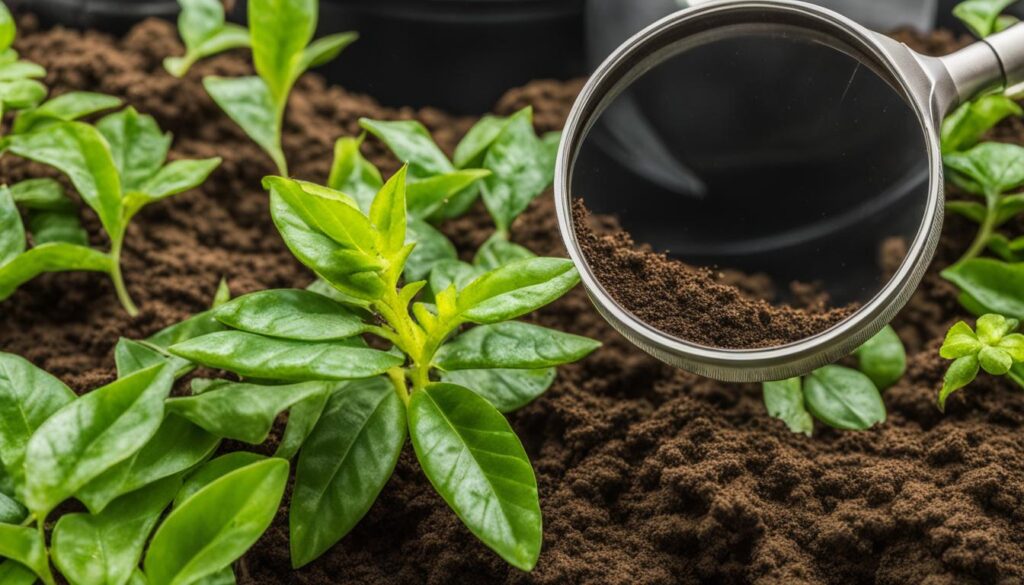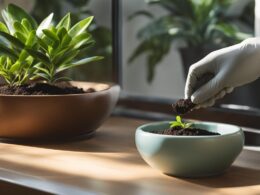Magnesium is an essential nutrient for plant growth and plays a crucial role in various plant functions. It is necessary for chlorophyll production, photosynthesis, cell division, protein formation, and many metabolic processes. A deficiency in magnesium can have serious consequences for plant health, leading to yellowing of leaves (chlorosis), particularly between the leaf veins (interveinal chlorosis), necrosis (death of leaf tissue), stunted growth, and reduced crop production. Identifying these signs of magnesium deficiency is crucial for maintaining the health and vitality of your plants.
Key Takeaways:
- Magnesium is essential for plant health, playing a vital role in chlorophyll production, photosynthesis, and various metabolic processes.
- Signs of magnesium deficiency include chlorosis (yellowing of leaves), interveinal chlorosis (yellowing between leaf veins), necrosis (leaf tissue death), slow growth, and poor crop production.
- Recognizing these symptoms early on allows for prompt intervention to ensure optimal plant health.
- Causes of magnesium deficiency in plants include leaching, sandy or acidic soil, potassium-rich soils, and inefficient fertilization.
- Providing plants with adequate magnesium can be achieved through organic compost, dolomitic limestone, Epsom salts, and proper soil management practices.
The Role of Magnesium in Plant Health
Magnesium is a vital nutrient for plant health as it plays multiple roles in plant growth and development. It is a central component of chlorophyll, the pigment responsible for the green color of leaves, and is essential for photosynthesis. Magnesium also contributes to cell division, protein formation, plant respiration, phosphate metabolism, nitrogen metabolism, protein synthesis, and water uptake. Without sufficient magnesium, plants are unable to carry out these vital functions, leading to nutrient deficiencies and poor overall plant health.
The primary function of magnesium in plants is its involvement in chlorophyll production, which is critical for photosynthesis. Chlorophyll allows plants to absorb sunlight and convert it into energy to support growth and development. Without adequate magnesium, plants cannot produce sufficient chlorophyll, resulting in reduced photosynthesis rates and overall poor plant health.
In addition to its essential role in chlorophyll production, magnesium also plays a key role in nutrient metabolism and protein synthesis. It helps plants absorb and utilize other essential nutrients, such as nitrogen and phosphorus, which are crucial for plant growth. Magnesium also aids in the synthesis of proteins, which are necessary for cell growth and development. Without enough magnesium, plants may experience slow growth and reduced protein synthesis, leading to stunted development and poor crop yield.
Furthermore, magnesium is involved in water uptake and transportation within plants. It helps regulate the opening and closing of stomata, tiny pores on the leaf surface that control the exchange of gases and water vapor. Proper stomatal function is essential for maintaining plant water balance, and magnesium plays a crucial role in this process. Without adequate magnesium, plants may experience water stress, leading to wilting, reduced nutrient uptake, and overall poor plant health.
| Magnesium Functions in Plant Health | Importance |
|---|---|
| Chlorophyll production for photosynthesis | Essential for energy production and overall plant growth |
| Nutrient metabolism and uptake | Facilitates the absorption and utilization of other essential nutrients |
| Protein synthesis | Crucial for cell growth, development, and overall plant health |
| Water uptake and transportation | Regulates stomatal function and ensures proper plant water balance |
Recognizing Symptoms of Magnesium Deficiency
Magnesium deficiency in plants can manifest in various symptoms, with chlorosis being the most prominent. Chlorosis refers to the yellowing of leaves, indicating a lack of chlorophyll production. However, it is important to differentiate magnesium deficiency chlorosis from other nutrient deficiencies to implement the appropriate corrective measures. In the case of magnesium deficiency, the yellowing primarily occurs between the leaf veins, a condition known as interveinal chlorosis. The veins themselves retain their green color.
Initially, interveinal chlorosis appears on older lower leaves and may gradually progress to affect younger leaves as the deficiency worsens. In severe cases, the leaves may even develop red, purple, or brown tints. Furthermore, necrosis or tissue death can occur, compromising the plant’s overall health. Alongside chlorosis, plants experiencing magnesium deficiency often exhibit slow growth and produce poor yields.
To summarize, key symptoms of magnesium deficiency in plants include:
- Chlorosis manifested as yellowing between leaf veins (interveinal chlorosis)
- Progression of interveinal chlorosis from older lower leaves to younger leaves
- Possible development of red, purple, or brown tints in leaves
- Necrosis or death of leaf tissue
- Slow growth and reduced crop yields
The Role of Magnesium in Plant Health
Magnesium deficiency in plants can have detrimental consequences for their overall health and growth. The next section will explore the vital role magnesium plays in various plant functions.
Common Causes of Magnesium Deficiency in Plants
Magnesium deficiency in plants can be caused by a variety of factors. Understanding the common causes can help you prevent and address this issue effectively. Some of the primary causes of magnesium deficiency include:
- Leaching: Heavy rainfall or excessive irrigation can lead to leaching, where magnesium is washed away from the soil. This is particularly common in sandy soils that have poor nutrient retention.
- Sandy Soil: Sandy soils have low cation exchange capacity, meaning they struggle to hold on to essential nutrients like magnesium. As a result, magnesium can quickly become unavailable to plants in sandy soil.
- Acidic Soil: Acidic soils with a low pH can reduce the solubility of magnesium, making it less available to plants. If your soil is naturally acidic, it may be more prone to magnesium deficiency.
- Potassium-Rich Soils: High levels of potassium in the soil can interfere with the uptake of magnesium by plants. Potassium-rich soils may inhibit the ability of plants to absorb sufficient magnesium, leading to deficiencies.
- Inefficient Fertilization: If your plants are not receiving adequate nutrients from fertilizers, including magnesium, deficiencies can occur. It is essential to ensure proper and efficient fertilization to prevent magnesium deficiency.
By understanding these common causes of magnesium deficiency, you can take the necessary steps to address them and promote healthy plant growth. It’s essential to assess your soil conditions, adjust fertilization practices, and provide the appropriate amendments to ensure that your plants have access to sufficient magnesium.
Table: Comparative Analysis of Magnesium Availability in Different Soil Types
| Soil Type | Magnesium Availability |
|---|---|
| Sandy Soil | Low |
| Loamy Soil | Moderate |
| Clay Soil | High |
Note: The table above provides a general comparison of magnesium availability in different soil types. It is important to conduct soil tests for accurate assessment and to determine the specific needs of your plants.
Addressing and preventing magnesium deficiency in plants requires an understanding of the underlying causes. By taking appropriate measures to mitigate these causes, you can maintain optimal magnesium levels and promote the overall health and productivity of your plants.
Providing Plants with Adequate Magnesium
To ensure the health and vitality of your plants, it is essential to provide them with an adequate supply of magnesium. There are several effective methods for enriching your soil with this essential nutrient.
1. Organic Compost:
One of the best ways to provide magnesium to your plants is through the use of organic compost. Compost is rich in nutrients, including magnesium, and helps to improve soil structure and moisture retention. Incorporating a generous amount of compost into your soil before planting will provide a continuous source of magnesium throughout the growing season.
2. Dolomitic Limestone:
Another method to increase magnesium levels in your soil is by using dolomitic limestone. This natural rock contains calcium magnesium carbonate, which helps to raise soil pH and enhance the availability of magnesium. Simply spread a layer of dolomitic limestone over your soil and incorporate it into the top few inches.
3. Epsom Salts:
In cases of severe magnesium deficiency and low soil pH, applying Epsom salts can provide a quick remedy. Epsom salts, or magnesium sulfate, can be dissolved in water and applied as a foliar spray. Mix a 2% solution of Epsom salts and spray it directly onto the leaves of affected plants. This allows for immediate absorption of magnesium and can help relieve deficiency symptoms.
4. Soil pH and Watering Practices:
Maintaining the proper pH level in your soil is also crucial for optimal magnesium uptake. Most plants prefer a slightly acidic to neutral soil pH (around 6.0-7.0) for efficient nutrient absorption. Regularly test your soil pH and adjust it, if necessary, using organic amendments or pH-adjusting compounds.
In addition, proper watering practices can help ensure that plants can uptake nutrients effectively. Overwatering or underwatering can hinder nutrient absorption, including magnesium. Water your plants deeply and consistently, allowing the soil to dry slightly between watering sessions.
By providing your plants with adequate magnesium through organic compost, dolomitic limestone, and Epsom salts, and maintaining proper soil pH and watering practices, you can ensure that they receive the essential nutrients they need for healthy growth and development.
How Can I Prevent Magnesium Deficiency in Plants While Growing Herbs and Flowers Together in Pots?
When planting herbs and flowers together in pots, it’s important to prevent magnesium deficiency in plants. To do this, use a balanced fertilizer with magnesium, maintain proper soil pH, and avoid overwatering. Regularly inspect the leaves for yellowing, as it can be a sign of magnesium deficiency.
Conclusion
In conclusion, maintaining optimal levels of magnesium is crucial for the health and vitality of your plants. A deficiency in magnesium can have detrimental effects on plant growth, leading to symptoms such as chlorosis, interveinal chlorosis, slow plant growth, and poor crop production.
By recognizing these signs of magnesium deficiency, you can take proactive measures to support your plants’ nutrient needs. Incorporating organic compost into your soil provides a continuous supply of magnesium and other essential nutrients. Adjusting soil pH with dolomitic limestone can enhance magnesium uptake, while monitoring soil moisture and implementing proper watering practices ensures optimal nutrient absorption.
Remember, nutrient management is key to maintaining vibrant, healthy plants. Regular monitoring of plant health and symptom recognition enables you to address deficiencies promptly and provide the necessary nutrients for your plants to thrive. By prioritizing magnesium and other essential nutrients, you can create an environment conducive to optimal plant growth and ensure the long-term health of your garden.
FAQ
What are the signs of magnesium deficiency in plants?
The signs of magnesium deficiency in plants include chlorosis (yellowing of leaves), particularly between the leaf veins (interveinal chlorosis), necrosis (death of leaf tissue), stunted growth, and reduced crop production.
What is the role of magnesium in plant health?
Magnesium plays multiple roles in plant growth and development, including chlorophyll production, photosynthesis, cell division, protein formation, plant respiration, phosphate metabolism, nitrogen metabolism, protein synthesis, and water uptake.
How do I recognize symptoms of magnesium deficiency in plants?
Symptoms of magnesium deficiency in plants include chlorosis (yellowing of leaves) between the leaf veins, slow growth, poor crop yield, and in severe cases, red, purple, or brown tints on leaves and necrosis (leaf tissue death).
What are the common causes of magnesium deficiency in plants?
Common causes of magnesium deficiency in plants include heavy rainfall and leaching, particularly in light, sandy soil, acidic soil with a low pH, potassium-rich soils that prioritize potassium uptake over magnesium, inefficient fertilization, and cold, wet environments.
How can I provide plants with adequate magnesium?
To ensure plants receive sufficient magnesium, it is important to establish a foundation of rich organic compost, amend soil with dolomitic limestone to improve soil pH and facilitate magnesium uptake, and in severe cases, apply an Epsom salt foliar spray (2% solution). Monitoring soil pH, watering practices, and other factors is also essential.
What is the importance of recognizing magnesium deficiency in plants?
Recognizing the signs of magnesium deficiency in plants is crucial for maintaining their health and vitality. By identifying and addressing deficiencies, such as through providing adequate magnesium, gardeners can promote vibrant, healthy plant growth and optimize crop yield.










